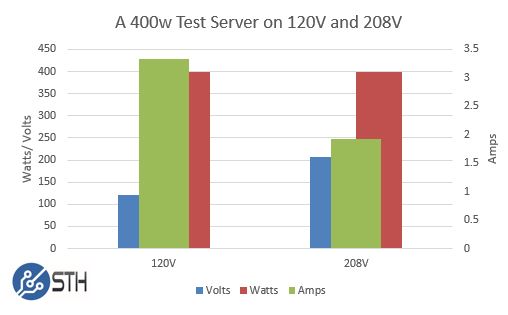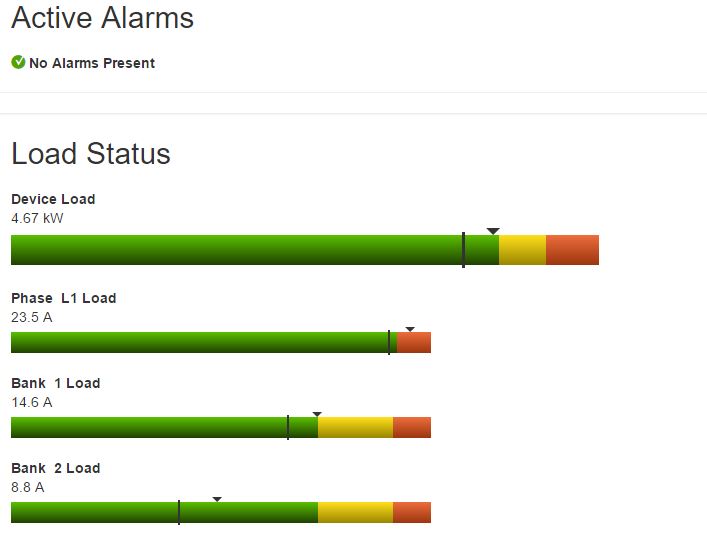One of the biggest questions we get about data center power is how much you can use. For example, if you purchase a “20A” cabinet, what does that mean? In this brief article, we are going to add a few of the most common questions and answers we see in this area.
Data Center Power – What are these Amps and Volts?
This is a surprisingly common question. There are likely millions of articles on the Internet, textbooks, and other resources with great explanations. For our purposes, we are going to give you the absolute minimum you need to know about Amps and Volts. Here is an example we have used between Volts Watts and Amps using a hypothetical 400W test server:

The first part of any description you will read is likely to start with Ohm’s law: V=IR. V is voltage. I is current (Amps). R is resistance. If you wanted to know how much power in Watts a circuit has, you can use Amps * Volts = Watts. Here are a few typical examples for North American commodity racks:
- 15A 110V circuit = 15 * 110 = 1650W
- 15A 120V circuit = 15 * 120 = 1800W
- 20A 208V circuit = 20 * 208 = 4160W
- 30A 208V circuit = 30 * 208 = 6240W
If you have a full 42U or larger, rack then the 15A circuits are often nowhere near enough. Modern 2U 4-Node chassis such as the Supermicro BigTwin we reviewed can easily sustain more power than 15A 120V circuits can supply.
Data Center Power – Can I use all 6kW?
One question we recently received from a STH reader looking for data center power was whether they could use all ~6kW in a 30A 208V circuit. The answer is: do not plan on it.
Although most data centers will quote power figures of 30A 208V, the reality is that that is maximum power delivery. Your sustained usage should not be above 80% of that number. If you are booting a machine, you may go temporarily above that 80% threshold, but you cannot sustain load above. Here is what it looks like:
- 15A 110V circuit = 15 * 110 = 1650W * 80% = 1320W
- 15A 120V circuit = 15 * 120 = 1800W * 80% = 1440W
- 20A 208V circuit = 20 * 208 = 4160W * 80% = 3328W
- 30A 208V circuit = 30 * 208 = 6240W * 80% = 4992W
That 20% safety margin will ensure your circuit stays up and safe. Here is what a 30A 208V circuit PDU looks like as it is approaching capacity:

We are not going to go into Single v. 3-Phase power in this article.
Other Considerations
We did want to highlight some work we did regarding 120V v. 208V power efficiency. 208V (and higher voltage) power will be more efficient than 120V. We are going to have a more thorough piece soon on this but it is fair to assume that modern server, storage, and networking power supplies will be around 2% more efficient using 208V power than 120V. As circuits get larger, that 2% can equal another piece of equipment in a 208V rack v. a 120V rack.
These days, most gear can operate at 110-240V without issue. Higher voltages are becoming popular in hyperscale data centers, but for commodity hosting, you will likely see 110-240V circuits.
Final Words
The key equation for most circuit providers in the data center is Amps * Volts * 80% = Continuous use wattage. Do use the additional 20% only as a safety margin. If you have a larger installation, instead of being billed on a circuit you may be given a power allowance (e.g. 20kW across six racks) or may even be billed based on actual power used. These are generally arrangements that require more data center space instead of 1-3 racks of gear. There are other aspects we did not go into in this article such as common connectors, single versus three phase power, A+B power, redundancy, disaster planning and so forth. Data center power is a complex a multi-billion dollar a year industry. We simply wanted to answer the question, how much power can you actually use on a data center circuit.
If you have additional questions, stop by the STH forums where there is an active community that work with data center power daily.



